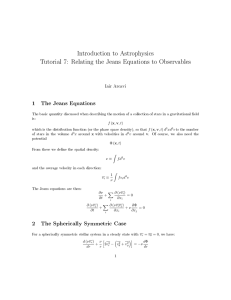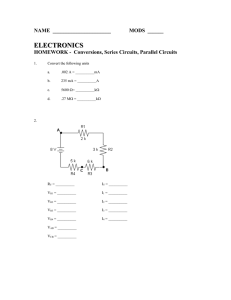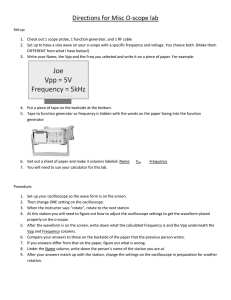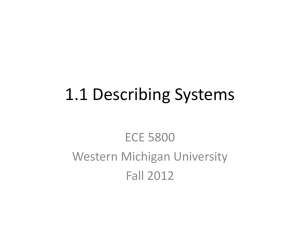MIC2557 - Farnell
advertisement
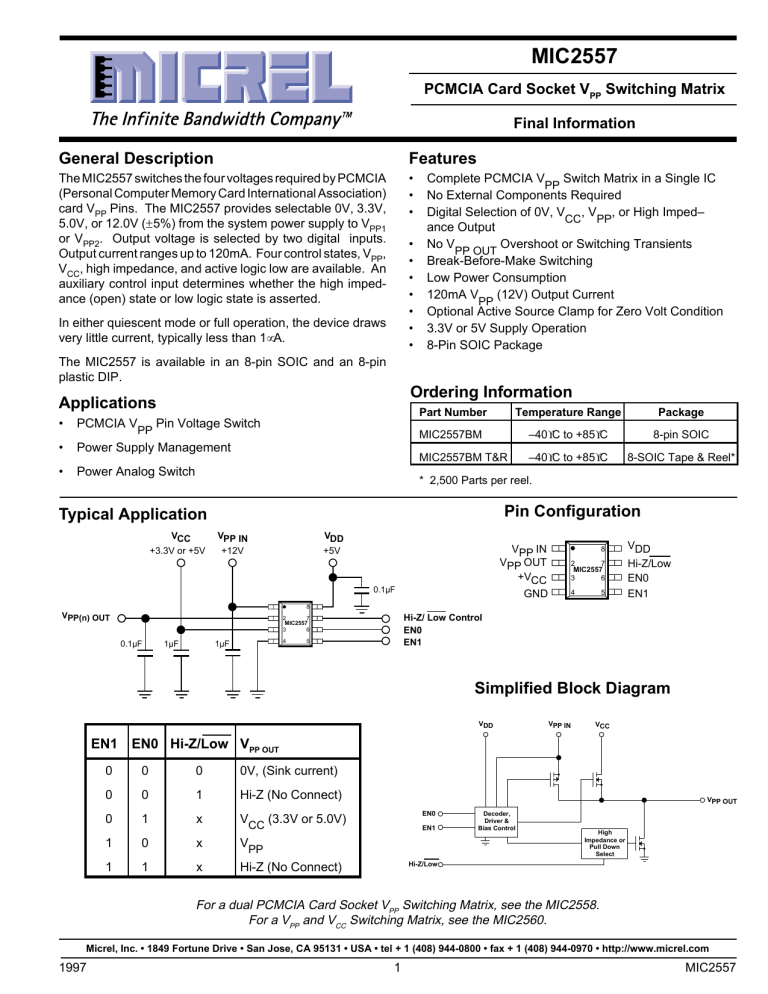
MIC2557 Micrel MIC2557 PCMCIA Card Socket VPP Switching Matrix Final Information General Description Features The MIC2557 switches the four voltages required by PCMCIA (Personal Computer Memory Card International Association) card VPP Pins. The MIC2557 provides selectable 0V, 3.3V, 5.0V, or 12.0V (±5%) from the system power supply to VPP1 or VPP2. Output voltage is selected by two digital inputs. Output current ranges up to 120mA. Four control states, VPP, VCC, high impedance, and active logic low are available. An auxiliary control input determines whether the high impedance (open) state or low logic state is asserted. • • • • • • • • • • In either quiescent mode or full operation, the device draws very little current, typically less than 1µA. Complete PCMCIA VPP Switch Matrix in a Single IC No External Components Required Digital Selection of 0V, V , V , or High Imped– CC PP ance Output Overshoot or Switching Transients No V PP OUT Break-Before-Make Switching Low Power Consumption 120mA VPP (12V) Output Current Optional Active Source Clamp for Zero Volt Condition 3.3V or 5V Supply Operation 8-Pin SOIC Package The MIC2557 is available in an 8-pin SOIC and an 8-pin plastic DIP. Ordering Information Applications • PCMCIA V • Power Supply Management • Power Analog Switch PP Part Number Temperature Range Package MIC2557BM –40°C to +85°C 8-pin SOIC MIC2557BM T&R –40°C to +85°C 8-SOIC Tape & Reel* Pin Voltage Switch * 2,500 Parts per reel. Pin Configuration Typical Application VCC +3.3V or +5V VPP IN +12V VDD +5V VPP IN VPP OUT +VCC 0.1µF 8 2 7 MIC2557 3 6 GND 4 5 VDD Hi-Z/Low EN0 EN1 8 VPP(n) OUT Hi-Z/ Low Control EN0 EN1 2 7 MIC2557 3 6 0.1µF 1µF 4 1µF 5 Simplified Block Diagram VDD EN1 VPP IN VCC EN0 Hi-Z/Low VPP OUT 0 0 0 0V, (Sink current) 0 0 1 Hi-Z (No Connect) 0 1 x VCC (3.3V or 5.0V) 1 0 x VPP 1 1 x Hi-Z (No Connect) VPP OUT EN0 EN1 Decoder, Driver & Bias Control High Impedance or Pull Down Select Hi-Z/Low For a dual PCMCIA Card Socket VPP Switching Matrix, see the MIC2558. For a VPP and VCC Switching Matrix, see the MIC2560. Micrel, Inc. • 1849 Fortune Drive • San Jose, CA 95131 • USA • tel + 1 (408) 944-0800 • fax + 1 (408) 944-0970 • http://www.micrel.com 1997 1 MIC2557 MIC2557 Micrel Absolute Maximum Ratings Power Dissipation, TAMBIENT ≤ 25°C SOIC Derating Factors (To Ambient) SOIC Storage Temperature Operating Temperature (Die) Operating Temperature (Ambient) Lead Temperature (5 sec) Supply Voltage, VPP IN VCC VDD Logic Input Voltages Output Current VPP OUT = 12V VPP OUT = VCC (Notes 1 and 2) 800 mW 4 mW/°C –65°C to +150°C 125°C –40°C to +85°C 260°C 15V 7.5V 7.5V –0.3V to VDD 600mA 250mA Logic Block Diagram VDD 8 1 VPP IN EN1 5 VDD VPP IN 3 VCC VDD EN0 6 VDD VDD 2 HiZ/ LOW 7 MIC2557 4 2 VPP OUT GND 1997 MIC2557 Micrel Electrical Characteristics: Symbol (Over operating temperature range with VDD = VCC= 5V, VPP IN = 12 V unless otherwise specified.) Parameter Conditions Min 2.2 Typ Max Units INPUT VIH Logic 1 Input Voltage VDD = 3.3V or 5.0V VIL Logic 0 Input Voltage VDD = 3.3V or 5.0V VIN (Max) Input Voltage Range IIN Input Current VOL V 0.8 V VDD V 0 V < VIN < VDD ±1 µA Clamp Low Output Voltage EN0 = EN1 = HiZ = 0, ISINK = 1.6mA 0.4 V IOUT, Hi-Z High Impedance Output Leakage Current EN0 = EN1 = 0, HiZ = 1 0 ≤ VPP OUT ≤ 12V 1 10 µA ROC Clamp Low Output Resistance Resistance to Ground. ISINK = 2mA EN0 = EN1 =0,HiZ=0 130 250 Ω RO Switch Resistance, VPP OUT = VCC IPP OUT = –10 mA (Sourcing) 2.5 5 Ω RO Switch Resistance, VPP OUT = VPP IN IPP OUT = –100 mA (Sourcing) 0.5 1 Ω –5 OUTPUT SWITCHING TIME (See Figure 1) t1 Delay + Rise Time VPP OUT = 0V to 5V (Notes 3, 5) 15 50 µs t2 Delay + Rise Time VPP OUT = 5V to 12V (Notes 3, 5) 12 50 µs t3 Delay + Fall Time VPP OUT = 12V to 5V (Notes 3, 5) 25 75 µs t4 Delay + Fall Time VPP OUT = 5V to 0V (Notes 3, 5) 45 100 µs t5 Output Turn-On Delay VPP OUT = Hi-Z to 5V (Notes 4, 5) 10 50 µs t6 Output Turn-Off Delay VPP OUT = 5V to Hi-Z (Notes 4, 5) 75 200 ns – 1 µA POWER SUPPLY IDD VDD Supply Current ICC VCC Supply Current IPP OUT = 0 – 1 µA IPP IPP Supply Current VPP OUT = 0 V or VPP . IPPOUT = 0. – 10 µA VPP OUT = VCC 10 40 µA 1997 3 MIC2557 MIC2557 Micrel Electrical Characteristics, (continued) Symbol Parameter Conditions Min Typ Max Units 6 V POWER SUPPLY, continued VCC Operating Input Voltage VDD Operating Input Voltage 2.8 6 V VPP IN Operating Input Voltage 8.0 14.5 V NOTE 1: NOTE 2: NOTE 3: NOTE 4: NOTE 5: Functional operation above the absolute maximum stress ratings is not implied. Static-sensitive device. Store only in conductive containers. Handling personnel and equipment should be grounded to prevent damage from static discharge. With RL = 2.9kΩ and C = 0.1µF on V . RL = 2.9kΩ. RL is connected to VCC during t5 , and is connected to ground during t6. Rise and fall times are measured to 90% of the difference between initial and final values. OUT PP OUT 3V Hi-Z/Low 0 3V EN0 0 3V EN1 0 12V VPP OUT 5V 0 t1 t2 t3 t4 t5 t6 Figure 1. Timing Diagram MIC2557 4 1997 MIC2557 Micrel Applications Information 5V PCMCIA VPP control is easily accomplished using the MIC2557 voltage selector/switch IC. Two control bits determine output voltage and standby/operate mode condition. Output voltages of 0V (defined as less than 0.4V), VCC (3.3V or 5V), VPP, or a high impedance state, are available. When either the high impedance or low voltage conditions are selected, the device switches into "sleep" mode, and draws only nanoamperes of leakage current. VCC Switch System Power Supply VCC 12V EN0 EN1 VPP IN VCC VPP1 MIC2557 PCMCIA Card Slot A The MIC2557 is a low-resistance power MOSFET switching matrix that operates from the computer system main power supply. Device power is obtained from VDD, which may be either 3.3V or 5V, and FET drive is obtained from VPP IN (usually +12V). Internal break-before-make switches determine the output voltage and device mode. EN0 EN1 VPP IN VCC VPP2 MIC2557 Supply Bypassing PCMCIA Card Slot Controller For best results, bypass VCC and VPP IN at their inputs with 1µF capacitors. VPP OUT should have a 0.01µF to 0.1µF capacitor for noise reduction and electrostatic discharge (ESD) damage prevention. Larger values of output capacitor will create large current spikes during transitions, requiring larger bypass capacitors on the VCC and VPP IN pins. VCC EN0 EN1 VPP IN VCC VPP1 MIC2557 PCMCIA Card Slot B 5V System Power 3.3V Supply VCC Select and Switch VCC EN0 EN1 12V EN0 EN1 VPP IN VCC VPP IN VCC VPP2 MIC2557 VPP1 MIC2557 Figure 3. MIC2557 Typical two slot PCMCIA application with single 5.0V VCC. PCMCIA Card Slot A PCMCIA Implementation EN0 EN1 PCMCIA Card Slot Controller VPP IN VCC VCC Select and Switch EN0 EN1 The Personal Computer Memory Card International Association (PCMCIA) specification requires two VPP supply pins per PCMCIA slot. VPP is primarily used for programming Flash (EEPROM) memory cards. The two VPP supply pins may be programmed to different voltages. Fully implementing PCMCIA specifications requires two MIC2557, and a controller. Figure 2 shows this full configuration, supporting both 5.0V and 3.3V VCC operation. Figure 3 is a simplified design with fixed VCC = 5V. Palmtop computers, where size and battery life are tantamount, can sometimes use a compromise implementation, with VPP1 tied to VPP2 (see Figure 4). VPP2 MIC2557 VPP IN VCC VCC VPP1 MIC2557 PCMCIA Card Slot B EN0 EN1 VPP IN VCC When a memory card is initially inserted, it should receive VCC, usually 5.0V ±5%. The card sends a handshaking data stream to the controller, which then determines whether or not this card requires VPP and if the card is designed for 5.0V or 3.3V VCC. If the card uses 3.3V VCC, the controller commands this change, which is reflected on the VCC pins of both the PCMCIA slot and the MIC2557. VPP2 MIC2557 During Flash memory programming, the PCMCIA controller outputs a (1,0) to the MIC2557, which connects VPP IN to Figure 2. MIC2557 Typical two slot PCMCIA application with dual VCC (5.0V or 3.3V). 1997 5 MIC2557 MIC2557 Micrel 3.3V System Power Supply 3.3V to 12V DC–DC Converter EN0 EN1 PCMCIA Card Slot Controller If no card is inserted, or the system is in sleep mode, the controller outputs either a (0,0) or a (1,1) to the MIC2557. Either input places the switch into its shutdown mode, where only a small leakage current flows. VCC Switch VPP IN VCC VDD VPP1 MIC2557 The HiZ/Low input controls the optional logic low output clamp. With HiZ/Low in the high state and ENO = EN1 = 0, VPP OUT enters a high impedance (open) state. With HiZ/ Low in the low state and EN0 = EN1 = 0, VPP OUT is clamped to ground, providing a logic low signal. The clamp does not require DC bias current for operation. PCMCIA Card Slot VPP2 MOSFET drive and bias voltage is derived from VPP IN. Internal device control logic is powered from VDD, which should be connected to the same supply voltage as the PCMCIA controller (normally either 3.3V or 5V). Figure 4. MIC2557 Palmtop application. Note that the VPP1 and VPP2 pins are combined. Although this does not fully satisfy PCMCIA specifications, it simplifies the circuitry and is acceptable in certain applications. Output Current VPP OUT. The low ON resistance of the MIC2557 switch requires only a small bypass capacitor on VPP OUT, with the main filtering action performed by a large filter capacitor on VPP IN. The VPP OUT transition from VCC to 12.0V typically takes 25µS. After programming is completed, the controller outputs a (0,1) to the MIC2557, which then reduces VPP OUT to the VCC level. Break-before-make switching action reduces switching transients and lowers maximum current spikes through the switch from the output capacitor. MIC2557 MIC2557 output switches are capable of far more current than usually needed in PCMCIA applications. PCMCIA VPP output current is limited primarily by switch resistance voltage drop (I x R) and the requirement that VPP OUT cannot drop more than 5% below nominal. VPP OUT will survive output short circuits to ground if VPP IN and VCC are current limited by the regulator that supplies these voltages. 6 1997 MIC2557 Micrel Package Information 0.026 (0.65) MAX) PIN 1 0.157 (3.99) 0.150 (3.81) DIMENSIONS: INCHES (MM) 0.050 (1.27) TYP 0.064 (1.63) 0.045 (1.14) 0.197 (5.0) 0.189 (4.8) 0.020 (0.51) 0.013 (0.33) 0.0098 (0.249) 0.0040 (0.102) 0°–8° SEATING PLANE 45° 0.010 (0.25) 0.007 (0.18) 0.050 (1.27) 0.016 (0.40) 0.244 (6.20) 0.228 (5.79) 8-Pin SOP (M) 1997 7 MIC2557 MIC2557 Micrel MICREL INC. 1849 FORTUNE DRIVE TEL + 1 (408) 944-0800 FAX SAN JOSE, CA 95131 + 1 (408) 944-0970 WEB USA http://www.micrel.com This information is believed to be accurate and reliable, however no responsibility is assumed by Micrel for its use nor for any infringement of patents or other rights of third parties resulting from its use. No license is granted by implication or otherwise under any patent or patent right of Micrel Inc. © 1997 Micrel Incorporated MIC2557 8 1997

